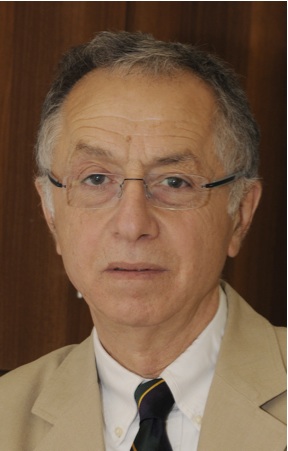|
|
Biography |
|
|
 Hamza El Dorry is a Professor and Chair of the Department of Biology at The American University of Cairo.He obtained a BSc. in Toxicology and Pesticides Chemistry from the University of Alexandria’s Faculty of Agriculture. He has a PhD in Biochemistry with a focus in enzymology and protein chemistry and habilitation in biochemistry and molecular Biology from the Department of Biochemistry, Institute of Chemistry, University of Sao Paulo, Brazil. Hamza completed his postdoctoral research at the Department of Molecular Biology, Albert Einstein College of Medicine, NY. He then moved to the Department of Physiological Chemistry, Roche Institute of Molecular Biology, Nutley, NJ. He served as a faculty member with Cornell University Medical College department of biochemistry, and later with the department of biochemistry at the University of Sao Paulo, Brazil.
Hamza was awarded the Cardiovascular Center Mellon Scholar in Basic Medical Sciences, and received the Scientific and Technological Merit Award by the Government of the State of Sao Paulo, Brazil. He has published more than 50 articles in refereed journals; served as the thesis advisor for five MSc and 12 PhD students; and as the mentor for seven post-doctoral fellows.His research interests are principally in the area of enzymology and regulation of metabolic pathways, regulation of gene expression and structural and functional genomics.
Hamza El Dorry is a Professor and Chair of the Department of Biology at The American University of Cairo.He obtained a BSc. in Toxicology and Pesticides Chemistry from the University of Alexandria’s Faculty of Agriculture. He has a PhD in Biochemistry with a focus in enzymology and protein chemistry and habilitation in biochemistry and molecular Biology from the Department of Biochemistry, Institute of Chemistry, University of Sao Paulo, Brazil. Hamza completed his postdoctoral research at the Department of Molecular Biology, Albert Einstein College of Medicine, NY. He then moved to the Department of Physiological Chemistry, Roche Institute of Molecular Biology, Nutley, NJ. He served as a faculty member with Cornell University Medical College department of biochemistry, and later with the department of biochemistry at the University of Sao Paulo, Brazil.
Hamza was awarded the Cardiovascular Center Mellon Scholar in Basic Medical Sciences, and received the Scientific and Technological Merit Award by the Government of the State of Sao Paulo, Brazil. He has published more than 50 articles in refereed journals; served as the thesis advisor for five MSc and 12 PhD students; and as the mentor for seven post-doctoral fellows.His research interests are principally in the area of enzymology and regulation of metabolic pathways, regulation of gene expression and structural and functional genomics.
|
|
|
|
|
|
|
Abstract |
|
|
|
|
The Red Sea Microbiome Project: Biotechnological Prospects of Marine Metagenomics |
|
|
|
|
|
The global oceans and seas cover more than 70% of the earth’s surface and are the largest habitat for living organisms on our planet. Due to their diverse and unique ecosystems, the world’s oceans are considered the centre of biodiversity of our planet and present one of the last unexplored frontiers for novel biotechnological products. The major biodiversity in oceans resides in microbial communities that comprise both free-living organisms and symbiotic forms that interact intimately with various marine organisms, and are mostly made up of uncultured or non-culturable microbes. Metagenomics, the genomic analysis of microorganisms collected from the environment, has contributed greatly to our understanding of the biochemical and physiological diversity of microbial communities in distinct environments. Together with King Abdullah University for Science and Technology (Kingdom of Saudi Arabia) and Woods Hole Oceanographic Institution (USA), we have initiated a comprehensive metagenomic analysis to characterize the microbial communities found in the many different environments in the Red Sea, including deep-sea brine pools. The Atlantis II deep is the largest brine pool (60 km2) located in the central Red Sea (21°21' N, 38°04' E) at a depth of 2200 meters from the sea surface. Environmental conditions in the deepest part of this brine, the Lower Convective Layer (LCL), are extremely harsh, and are characterized by high salinity (26%) and temperature (68 °C), low pH (5.3), anoxia, and a high concentration of heavy metals. Microorganisms adapted to this environment should possess proteins and enzymes with unique structural and enzymatic activities that allow them to survive under such exacting conditions. In this study, we have established four depth-related metagenomics datasets for the water column above the Atlantis II brine pool and performed a comprehensive analysis of 24 metagenomics datasets for surface and depth-related environments from 11 sites around the world’s oceans, including the datasets obtained at the Atlantis II basin. This broad metagenomics-based functional profiling analysis revealed distinct enzymes that can be used as indicators for environmental diagnosis of microbial functional activities in marine ecosystems. In addition, searching our metagenomic LCL database for enzymes with novel catalytic activities has revealed several candidates with potential biotechnological applications. One of these is mercuric reductase, an enzyme that has great potential for remediation of Hg pollution by reduction of Hg(II) to a volatile form. The computationally identified open reading frame of LCL mercuric reductase was synthesized and expressed in E. coli. The transformed cells were found to be resistant to high levels of mercury. Moreover, the purified enzyme was found to be catalytically stable at high temperature and salinity. Our identification of indicators for environmental diagnosis of microbial functional activities in marine ecosystems, and the functional characterization of novel enzymes in our LCL Atlantis II database for bioremediation process, should facilitate efforts to address detrimental anthropogenic effects on marine and terrestrial ecosystems. |
|
|
|
|